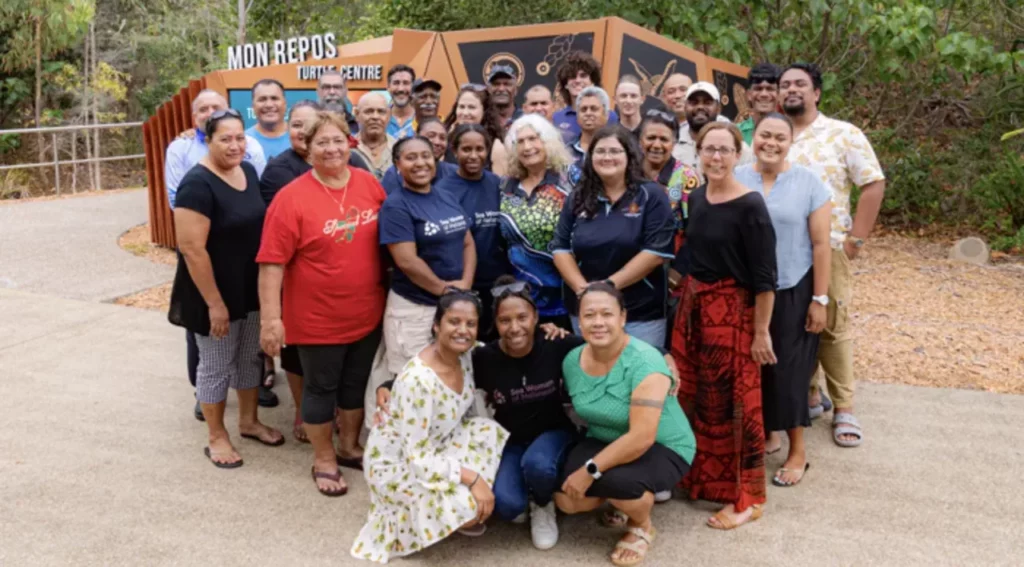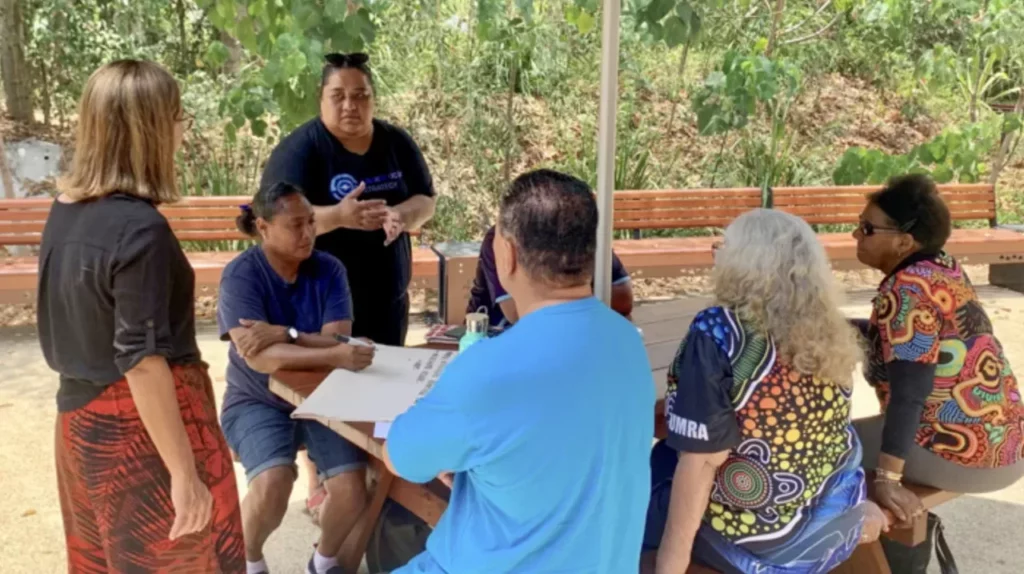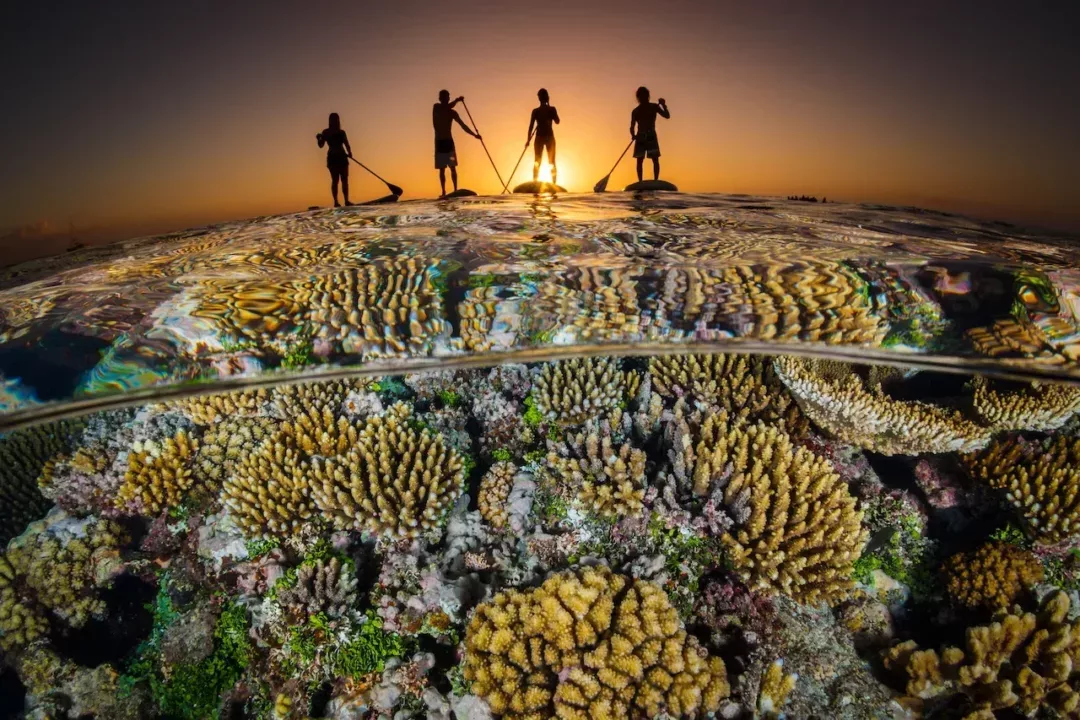Traditional ecological knowledge is being woven with western marine science and technology to strengthen understanding of changing coral reefs and to inform their management.
Pacific Island nations depend upon coral reefs for sustenance, income, and coastal protection. Over millennia, traditional ecological knowledge has guided sustainable management of natural resources in Australia and the wider Pacific. Climate change is accelerating its impacts on ecosystems and livelihoods across the globe and is widely recognised as the greatest threat to coral reefs.
AIMS scientists are working with Australia’s Gidarjil Development Corporation, Papua New Guinea’s Sea Women of Melanesia (SWoM), the Samoan Government and community, the Secretariat for the Pacific Regional Environmental Programme (SPREP), and Conservation International, to develop a coral reef monitoring framework for Pacific nations.
This framework will help Pacific communities – including Australia’s First Nation people – to incorporate the latest science and technology into traditional reef monitoring practises, to inform adaptive coral reef management in an uncertain future.

The second of three planned workshops to develop the framework was held in Bundaberg recently, following the first in Samoa in July.
AIMS Research Team Lead Dr Manuel Gonzalez Rivero said western science and traditional knowledge were both about observation and communicating how nature changed in response to pressures but this information was gathered and shared in very different ways.
“We’ve got a big challenge in bringing these two knowledge systems together because they are from different perspectives, but we are finding a visual way that allows this to flow,” he said.
“Nowadays anyone can take a photo – and it’s a really good platform to collect data for both Traditional Owners and scientists.
“AIMS have created ReefCloud, a platform that uses AI to help extract information from those images and put it in a language that is easily transferable and can inform decision makers about how reefs are changing and to identify those that most urgently need protection. Reefs are changing very quickly, so we really need to innovate in how we preserve coral reefs.”
Tuave Leti, a Aleipata District community leader, said Samoa’s reefs were still recovering from the earthquake and Tsunami of 2009 and this was impacting both the supply of seafood and industries such as tourism.
“Our way of living depends upon nature,” he said.
“This workshop is a great opportunity to share our different environments. I want to thank Australia for creating this opportunity.”

Vitolina Ah Kau, Marine Biodiversity Conservation Officer at the Samoan Ministry of Natural Resources and Environment, said currently, Samoa had no national data to provide a baseline snapshot of the condition of the nation’s coral reefs. “We aim to adapt and adopt the photo transect reef monitoring method so we can conduct a national baseline survey to determine the status of coral reefs in Samoa,” she said.
Naomi Longa, a SWoM co-director, said her organisation equipped Papua New Guinean (PNG) women with the training and resources to set up marine reserves in their communities. “We have a lot of photos from all around the coast of PNG and it’s a pain to manually sort through the images to see what’s happening,” she said. “Now we can just upload all these images to ReefCloud, and the AI can help us analyse them and give us data of how the corals are doing out on the reef.”
Ms Longa said the workshop was a unique opportunity to bring three distinct cultures together with scientists.
“It would be amazing if we can come with a design that suits all the cultures of the Pacific, offering a more standardised way of monitoring our reefs that comprised of both science and traditional knowledge,” she said. “I’m very excited to see how this is going to go, and to be developing something that can benefit every one of us.”
Gurang Elder Lola Tiger said a highlight was “meeting people from other cultures, making new friends, and finding out their struggles”. “It’s been a great experience, and I will go away better for it,” she said.
Taribelang Bunda Traditional Owner and Gidargil Senior Sea Ranger Kelvin Rowe said he was from saltwater people and felt a strong connection with the ocean. “The reef is very significant to us,” he said. “The sea turtle is one of our totems, and it’s treasured by us. At the workshop we all seem to be on the same page about what we want done and how we can help each other.”

Woppaburra Traditional Owner and Elder Bob Muir said that in his AIMS role as an Indigenous Partnership Coordinator, he created a bridge between AIMS scientists and Australia’s Traditional Owners to seek their consent for research on their Country and to be actively involved if they wished. “By sitting down and talking with Traditional Owners, AIMS scientists might discover some information or issues they need to consider in their research design,” he said. “Sometimes the information a Traditional Owner gives makes a big difference to a whole project.” AIMS scientists were now acknowledging Traditional Owner knowledge in science papers. “We’ve got to weave the different layers together – traditional and scientific knowledge systems – to make them stronger,” he said.
“This traditional knowledge exchange workshop is unique. I don’t think there are many places in the world that are approaching this issue of looking at different cultures and trying to make sure we engage in a proper and culturally appropriate way that’s respectful and understanding.”
The program is part of a four-year investment by AIMS and the Australian Government. It will help to build coral reef monitoring capabilities in the Pacific region by expanding the use of ReefCloud as part of the Pacific Coral Reef Action Plan.
It is also supported by the Global Coral Reef Monitoring Network (GCRMN), an operational network of the International Coral Reef Initiative (ICRI) and Accenture.
Source: Credit to AIMS Press Release

